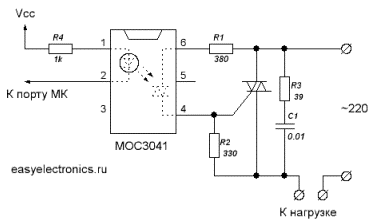Categories: Sharing experience, Practical Electronics, Novice electricians
Number of views: 78811
Comments on the article: 4
How to easily control a powerful AC load
 Sometimes you need a weak signal from the microcontroller to turn on a powerful load, such as a lamp in the room. This problem is especially relevant for developers. smart home. The first thing that comes to mind is a relay. But do not rush, there is a better way :)
Sometimes you need a weak signal from the microcontroller to turn on a powerful load, such as a lamp in the room. This problem is especially relevant for developers. smart home. The first thing that comes to mind is a relay. But do not rush, there is a better way :)
In fact, the relay is a continuous hemorrhage. Firstly, they are expensive, and secondly, to power the relay winding, an amplifying transistor is needed, since the weak microcontroller foot not capable of such a feat. Well, and thirdly, any relay is a very bulky design, especially if it is a power relay designed for high current.
If we are talking about alternating current, it is better to use triacs or thyristors. What it is? And now I’ll tell you.
If on the fingers, then the thyristor is similar to a diode, even the designation is similar. Passes current in one direction and does not let in the other. But he has one feature that distinguishes it from the diode radically - the control input.
If the opening current is not applied to the control input, the thyristor will not pass current even in the forward direction. But it is worth giving at least a brief impulse, as it immediately opens and remains open as long as there is direct voltage. If the voltage is removed or polarity reversed, the thyristor will close. The polarity of the control voltage should preferably coincide with the polarity of the voltage at the anode.
If you connect two thyristors in the opposite direction, you get a triac - a great thing for switching the load on alternating current.
On a positive half-wave, a sinusoid passes one, on the negative another. Moreover, they pass only in the presence of a control signal. If the control signal is removed, then in the next period both thyristors will shut down and the circuit will break. Krastota and only. Here it also needs to be used to manage household load.
But there is one subtlety - we commute a high-voltage power circuit, 220 volts. And our controller is low-voltage, it works at five volts. Therefore, in order to avoid excesses, you need to make a potential outcome. That is, to make sure that there is no direct electrical connection between the high-voltage and low-voltage parts. For example, make an optical separation. There is a special assembly for this - the MOC3041 triac optical driver. Wonderful thing!

Look at the connection diagram - there are just a few additional details and your power and control parts are divided among themselves. The main thing is that the voltage for which the capacitor is designed is one and a half two higher than the voltage in the outlet. You can not be afraid of power interference when you turn on and off the triac. In the optodriver itself, the signal is supplied by an LED, which means you can safely light it from the microcontroller leg without any additional tricks.
In general, it is possible to work without a decoupling, but it will also work, but it’s considered good practice to always make a potential decoupling between the power and control parts. This is the reliability and security of the entire system. Industrial solutions are so packed with optocouplers or all sorts of isolating amplifiers.
Well, as a triac, I recommend BT139 - with a good heatsink, this figovina easily drags a current of 16A through itself.
See also at bgv.electricianexp.com
:
